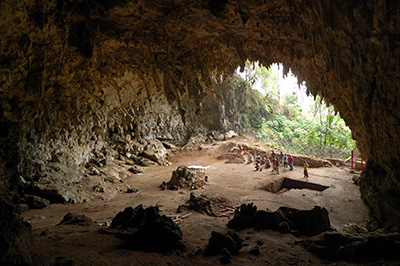
There are pygmies on Flores Island in Indonesia today but they are not related to the diminutive Flores humans discovered in 2004.
A fossil skeleton found in a cave on Flores Island, Indonesia, in 2004 turned out to be a previously unknown, very small species of human. Nicknamed the “hobbit” (officially Homo floresiensis), it remains a mysterious species with an unknown relationship to modern humans.
Intriguingly, the current inhabitants of Flores include a pygmy population living in a village near the Liang Bua cave where the fossils were found. An international team of scientists has now sequenced and analyzed the genomes of 32 people in this population. The analysis revealed evolutionary changes associated with diet and short stature in the pygmy population, but the researchers found no evidence of genetic elements that might have come from H. floresiensis.
…
Thus far, no one has been able to recover DNA from the H. floresiensis fossils. The researchers therefore searched the pygmy genome for any evidence of DNA sequences from an unknown ancient human lineage.
Green and other researchers previously recovered and sequenced DNA from fossils of other archaic humans—the Neanderthals and Denisovans—and determined that the genomes of some modern humans include DNA sequences inherited from those extinct human species. Those findings mean some interbreeding occurred in the distant past. The genomes of the Flores pygmies include small amounts of Neanderthal and Denisovan DNA, similar to other populations in Southeast Asia and Melanesia.
“Genetically, they’re not so different from other populations in that part of the world,” Green said. Tim Stephens, “No evidence of ‘hobbit’ ancestry in genomes of Flores Island pygmies” at UC Santa Cruz
The short modern-day stature is due to the same causes that act on other human groups.

Abstract: Flores Island, Indonesia, was inhabited by the small-bodied hominin species Homo floresiensis, which has an unknown evolutionary relationship to modern humans. This island is also home to an extant human pygmy population. Here we describe genome-scale single-nucleotide polymorphism data and whole-genome sequences from a contemporary human pygmy population living on Flores near the cave where H. floresiensis was found. The genomes of Flores pygmies reveal a complex history of admixture with Denisovans and Neanderthals but no evidence for gene flow with other archaic hominins. Modern individuals bear the signatures of recent positive selection encompassing the FADS (fatty acid desaturase) gene cluster, likely related to diet, and polygenic selection acting on standing variation that contributed to their short-stature phenotype. Thus, multiple independent instances of hominin insular dwarfism occurred on Flores. (open access) – Serena Tucci1, Samuel H. Vohr, Rajiv C. McCoy, Benjamin Vernot5, Matthew R. Robi, Evolutionary history and adaptation of a human pygmy population of Flores Island, Indonesia, Science 03 Aug 2018: Vol. 361, Issue 6401, pp. 511-516
DOI: 10.1126/science.aar8486 More.
From the BBC:
This is important because some scientists had wondered whether modern humans (Homo sapiens) could have mixed with the Hobbit population when they first arrived on the island thousands of years ago. In theory, this could have led to Hobbit genes being passed down into living people on the island.
Apparently not. Environment is now favored as the cause:
The most popular theory is that animals evolve smaller body size in circumstances where the environment or diet is poor over many generations. This may be because smaller individuals are at an advantage because of lower energy needs.
This current study seems to confirm these findings.
“Flores is a magical place where things go and get small,” said geneticist Prof Joshua Akey at Princeton University.Angus Davison, “Small height evolved twice on ‘Hobbit’ island of Flores[article title]” at BBC
So why is Flores, in particular, such a magical place? Lots of big people have lived on islands too. Also, in addition to island dwarfism, there is, just to complicate the picture, island gigantism, where life forms get bigger on islands. Oh well, another day, another paper…
Hat tip: Pos-darwinista whose lead blogger writes to say, “I always considered Homo floresiensis as a fully human being from the beginning.” Indeed, and one question we should be asking more often is, why was the default position so emphatically: Não! (No!)
See also: The Little Lady of Flores spoke from the grave. But said what, exactly?